Numerical Simulation and Tests of Lateral Bearing Capacity of Sloped Offshore Monopile Under Vertical Load and Lateral Cyclic Load
Abstract
1. Introduction
2. Model Tests of Pile Under Vertical Load and Lateral Load
2.1. Apparatus of Model Tests
2.2. Scheme of Model Tests
3. Analysis of Model Test Results
3.1. Effect of Vertical Load
3.2. Effect of Slope Angle
4. Numerical Model of Pile Under Vertical Load and Lateral Load
4.1. Establishment of the Numerical Model
4.2. Validation of the Numerical Model
4.3. Numerical Model of Offshore Monopile
5. Influence Analysis of Large-Diameter Monopile Under Vertical Load and Lateral Load
5.1. Influence of Relative Density
5.2. Influence of Slope Angle
5.3. Influence of Vertical Load
6. Prediction of Cumulative Displacement for Large-Diameter Monopile
7. Conclusions
- (1).
- The cumulative displacement of the pile increases logarithmically with the number of cyclic loads. Deformation of the pile is produced within 1000th cycles. After the 1000th cycle, the deformation of the pile is largely stable.
- (2).
- As the slope angle increases, the cumulative horizontal displacement of the single-pile foundation also increases. Compared to flat ground, the cumulative displacement of the pile at 10° and 20° slope sites increases by 32.8% and 114.8%, respectively.
- (3).
- As the vertical load increases, the cumulative horizontal displacement of the single-pile foundation decreases. When the vertical load is 3 N, the cumulative displacement at 0°, 10°, and 20° decreases by 19.7%, 17.6%, and 10.7%.
- (4).
- For large-diameter offshore monopiles situated on sloped sites under vertical-horizontal combined loading, cumulative displacement demonstrates a logarithmic growth characteristic with the increment of cycle counts. A predictive formula for cumulative deformation is developed, serving as a preliminary evaluation approach for such deformation. On account of insufficient cases from numerical computations and model tests, additional investigations are needed to optimize the developed model.
Author Contributions
Funding
Data Availability Statement
Acknowledgments
Conflicts of Interest
References
- Lin, M.; Jiang, C.; Chen, Z.; Liu, P.; Pang, L. A method for calculating lateral response of offshore rigid monopile in sand underslope effect. Ocean Eng. 2022, 259, 111812. [Google Scholar] [CrossRef]
- Jiang, C.; Zhang, Z.; He, J. Nonlinear analysis of combined loaded rigid piles in cohesionless soil slope. Comput. Geotech. 2020, 117, 103225. [Google Scholar] [CrossRef]
- Georgiadis, K.; Georgiadis, M. Undrained lateral pile response in sloping ground. J. Geotech. Geoenviron. Eng. 2010, 136, 1489–1500. [Google Scholar] [CrossRef]
- Georgiadis, K.; Georgiadis, M.; Anagnostopoulos, C. Lateral bearing capacity of rigid piles near clay slopes. Soils Found. 2013, 53, 144–154. [Google Scholar] [CrossRef]
- Liu, P.; Jiang, C.; Lin, M.; Chen, L.; He, J. Nonlinear analysis of laterally loaded rigid piles at the crest of clay slopes. Comput. Geotech. 2020, 126, 103715. [Google Scholar] [CrossRef]
- Peng, W.; Zhao, M.; Zhao, H.; Yang, C. Effect of slope on bearing capacity of laterally loaded pile based on asymmetric failure mode. Comput. Geotech. 2021, 140, 104469. [Google Scholar] [CrossRef]
- Rathod, D.; Muthukkumaran, K.; Thallak, S. Experimental Investigation on Behavior of a Laterally Loaded Single Pile Located on Sloping Ground. Int. J. Geomech. 2019, 19, 04019021. [Google Scholar] [CrossRef]
- Zhang, L.; Yue, S.; Peng, W.; Zhou, S. Experimental study on cyclic lateral response of piles in sandy sloping ground. Ocean Eng. 2023, 282, 115056. [Google Scholar] [CrossRef]
- Yue, S.; Zhang, L.; Zhou, S.; Peng, W.; Wu, G.; Zhao, M. Experimental investigation into effects of slope and loading characteristics on cyclic laterally loaded monopile in sand. Ocean Eng. 2024, 294, 116784. [Google Scholar] [CrossRef]
- Sawant, V.; Shukla, S. Three-dimensional finite element analysis of laterally loaded piles in sloping ground. Indian Geotech. J. 2012, 42, 278–286. [Google Scholar] [CrossRef]
- Ng, C.W.W.; Zhang, L. Three-dimensional analysis of performance of laterally loaded sleeved piles in sloping ground. J. Geotech. Geoenviron. Eng. 2001, 127, 499–509. [Google Scholar] [CrossRef]
- Pang, L.; Jiang, C.; Chen, L.J. Nonlinear Predictive Framework of the Undrained Clay Slope Effect on the Initial Stiffness of py Curves of Laterally Loaded Piles by FEM. J. Mar. Sci. Eng. 2022, 10, 1684. [Google Scholar] [CrossRef]
- Goryunov, B. Analysis of piles subjected to the combined action of vertical and horizontal loads (discussion). Soil Mech. Found. Eng. 1973, 10, 10–13. [Google Scholar] [CrossRef]
- Liang, F.Y.; Liao, C.C.; Mao, L.; Bai, W. Model tests on the behavior of a single pile under vertical-horizontal load. Build. Struct. 2013, 43, 92–94. [Google Scholar]
- Zhang, L.; Gong, X.-N.; Yang, Z.-X.; Yu, J.-L. Elastoplastic solutions for single piles under combined vertical and lateral loads. J. Cent. South Univ. Technol. 2011, 18, 216–222. [Google Scholar] [CrossRef]
- Liu, T.; Lai, Y.; He, B.; Lv, N. Influence of Vertical Load on the Lateral Response of Piles in Normally Consolidated and Over-Consolidated Clay: Centrifuge and Numerical Modelling. Front. Phys. 2022, 10, 908181. [Google Scholar] [CrossRef]
- Lu, W.; Zhang, G. Influence mechanism of vertical-horizontal combined loads on the response of a single pile in sand. Soils Found. 2018, 58, 1228–1239. [Google Scholar] [CrossRef]
- Mu, L.; Kang, X.; Feng, K.; Huang, M.; Cao, J. Influence of Vertical Loads on Lateral Behaviour of Monopiles in Sand. Eur. J. Environ. Civ. Eng. 2018, 22 (Suppl. S1), s286–s301. [Google Scholar] [CrossRef]
- Karasev, O.; Talanov, G.; Benda, S. Investigation of the Work of Single Situ-cast Piles Under Different Load Combinations. Soil Mech. Found. Eng. 1977, 14, 173–177. [Google Scholar] [CrossRef]
- Bartolomey, A. Experimental Analysis of Pile Groups Under Lateral Loads. In Proceedings of the Special Session 10 of the Ninth International Conference on Soil Mechanics and Foundation Engineering, Tokyo, Japan, 10–15 July 1977; pp. 187–188. [Google Scholar]
- Karthigeyan, S.; Ramakrishna, V.; Rajagopal, K. Influence of vertical load on the lateral response of piles in sand. Comput. Geotech. 2006, 33, 121–131. [Google Scholar] [CrossRef]
- Taheri, O.; Moayed, R.Z.; Nozari, M. Lateral soil-pile stiffness subjected to vertical and lateral loading. J. Geotech. Transp. Eng. 2015, 1, 30–37. [Google Scholar]
- Lu, W.; Zhang, G. New p-y curve model considering vertical loading for piles of offshore wind turbine in sand. Ocean Eng. 2020, 203, 107228. [Google Scholar] [CrossRef]
- Leblanc, C.; Houlsby, G.; Byrne, B. Response of stiff piles in sand to long-term cyclic lateral loading. Géotechnique 2010, 60, 79–90. [Google Scholar] [CrossRef]
- DNV-OS-J101; Offshore Standard: Design of Offshore Wind Turbine Structures. Det Norske Veritas: Hovek, Norway, 2013.
- Barari, A.; Bagheri, M.; Rouainia, M.; Ibsen, L.B. Deformation mechanisms for offshore monopile foundations accounting for cyclic mobility effects. Soil Dyn. Earthq. Eng. 2017, 97, 439–453. [Google Scholar] [CrossRef]
- Andersen, K. Cyclic soil parameters for offshore foundation design. Front. Offshore Geotech. III 2015, 5, 5–82. [Google Scholar]
- Nikitas, G.; Arany, L.; Aingaran, S.; Vimalan, J.; Bhattacharya, S. Predicting long term performance of offshore wind turbines using cyclic simple shear apparatus. Soil Dyn. Earthq. Eng. 2017, 92, 678–683. [Google Scholar] [CrossRef]
- Duncan, J.M.; Chang, C.Y. Nonlinear analysis of stress and strain in soils. J. Soil Mech. Found. Div. 1970, 96, 1629–1653. [Google Scholar] [CrossRef]
- Achmus, M.; Kuo, Y.; Abdel-Rahman, K. Behavior of monopile foundations under cyclic lateral load. Comput. Geotech. 2009, 36, 725–735. [Google Scholar] [CrossRef]
- Yang, Y.; Sun, Y.; Xu, C.; Iqbal, K.; DU, X. Predicting accumulated deformation of offshore large-diameter monopile using hollow cylinder apparatus. Ocean Eng. 2022, 261, 111984. [Google Scholar] [CrossRef]
- Sun, Y.; Xu, C.; Naggar, M.H.E.; Du, X.; Dou, P. Cumulative cyclic response of offshore monopile in sands. Appl. Ocean Res. 2023, 133, 103481. [Google Scholar] [CrossRef]
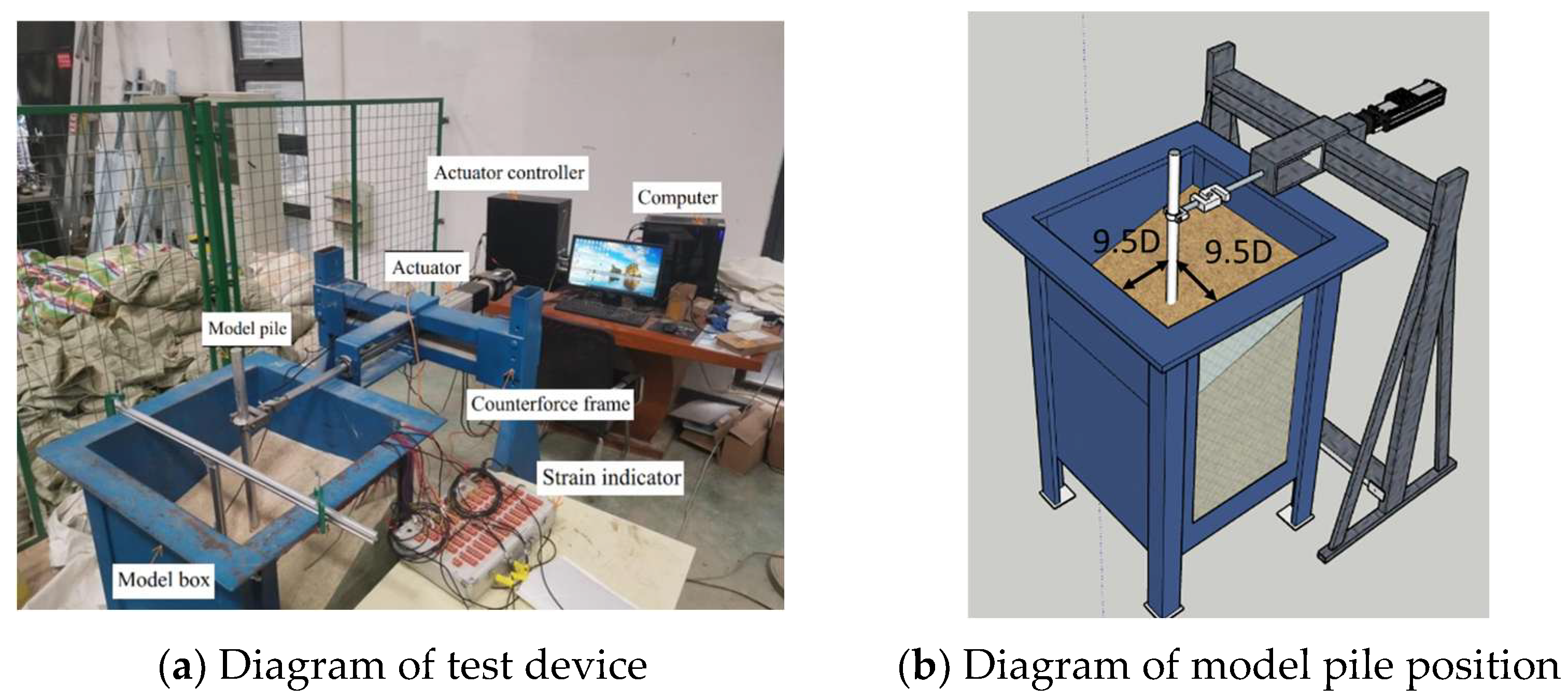



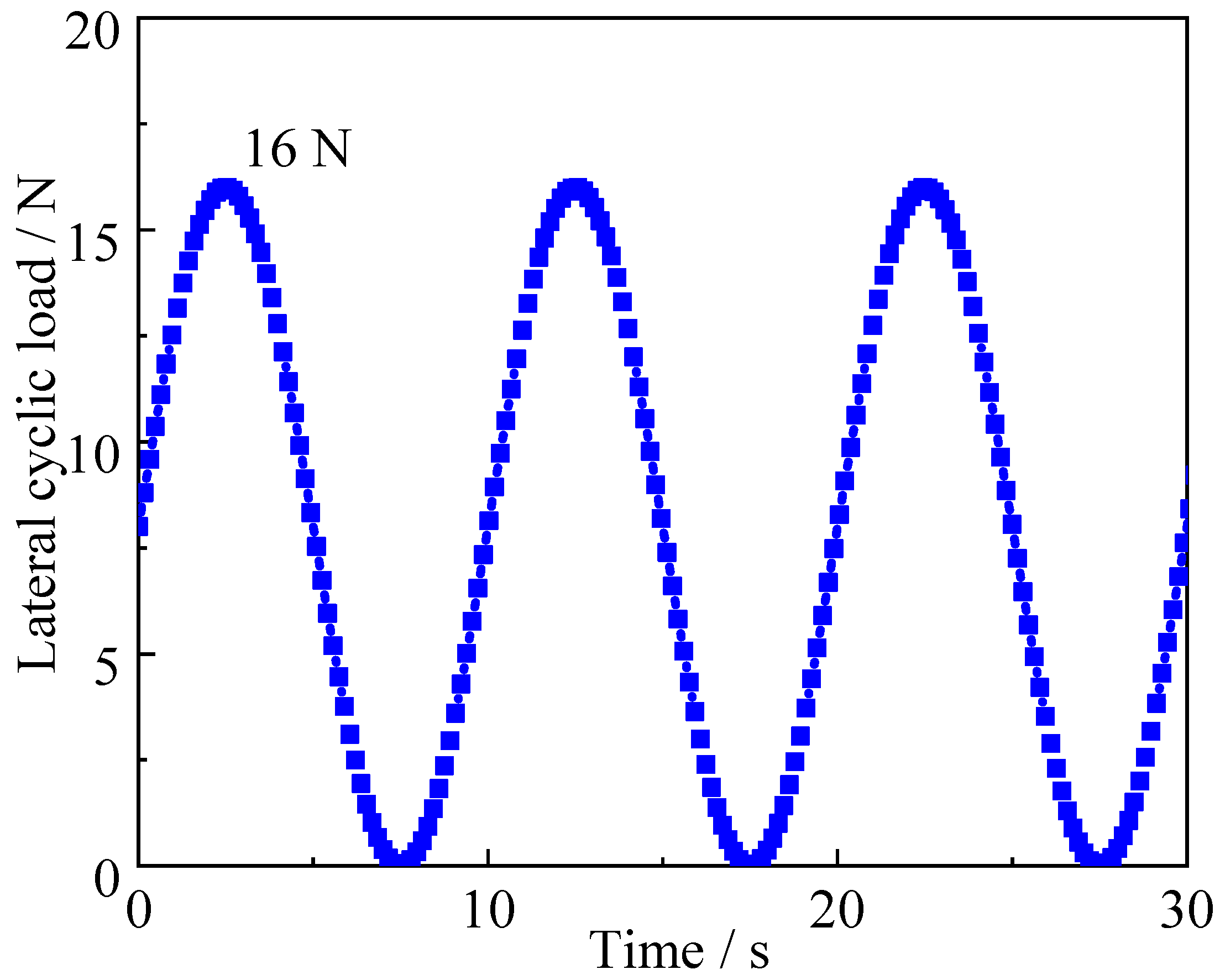

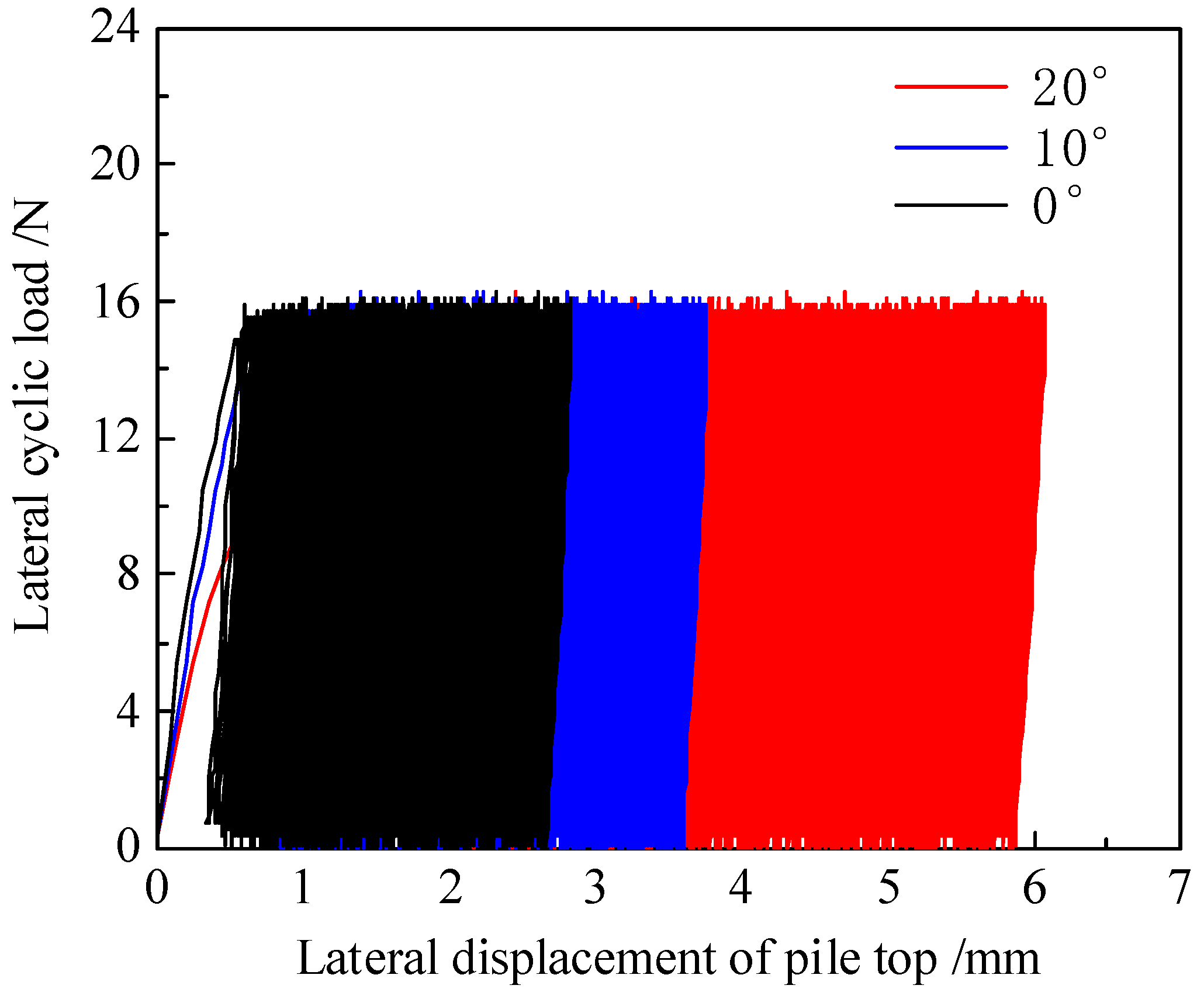
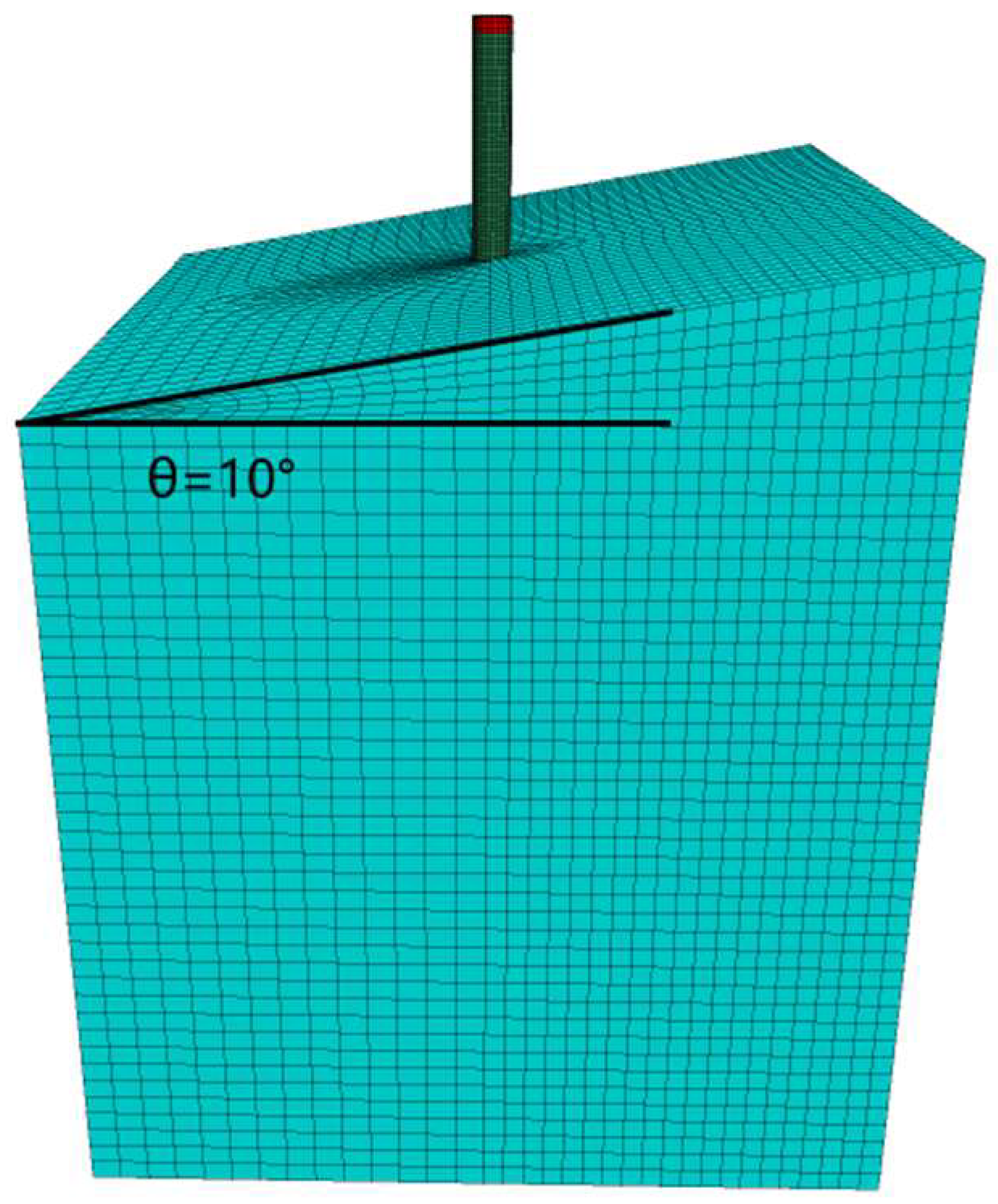
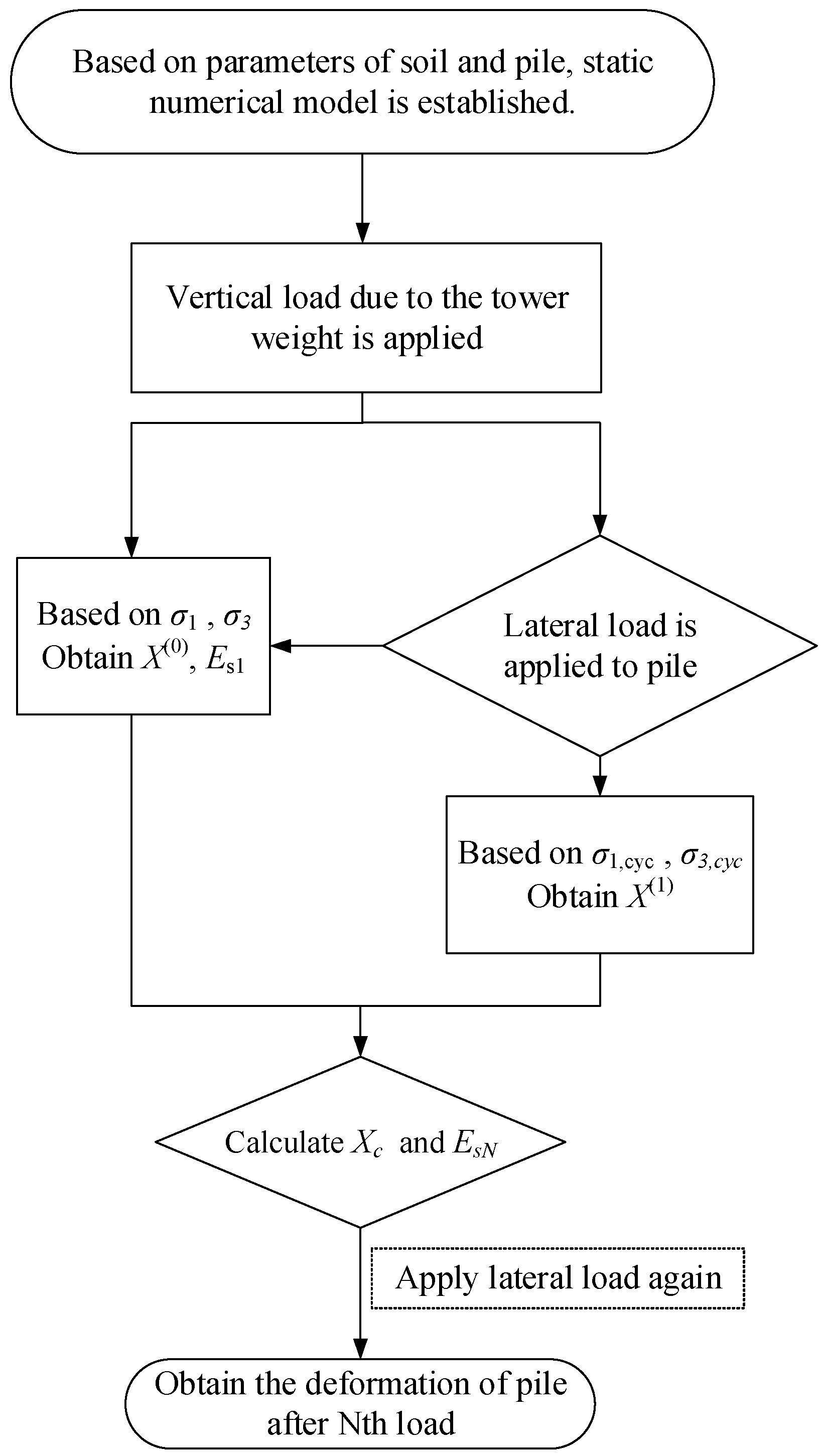


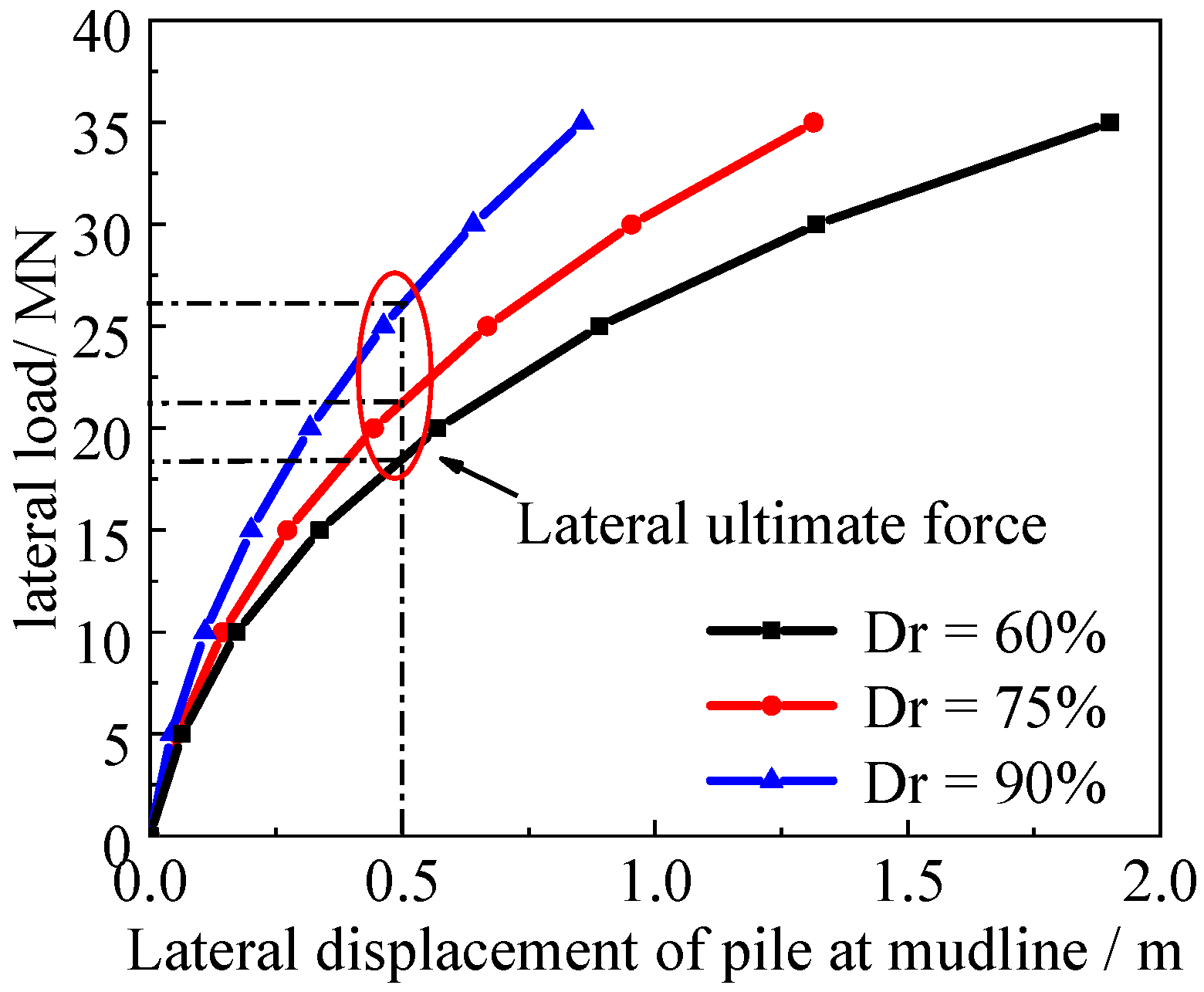
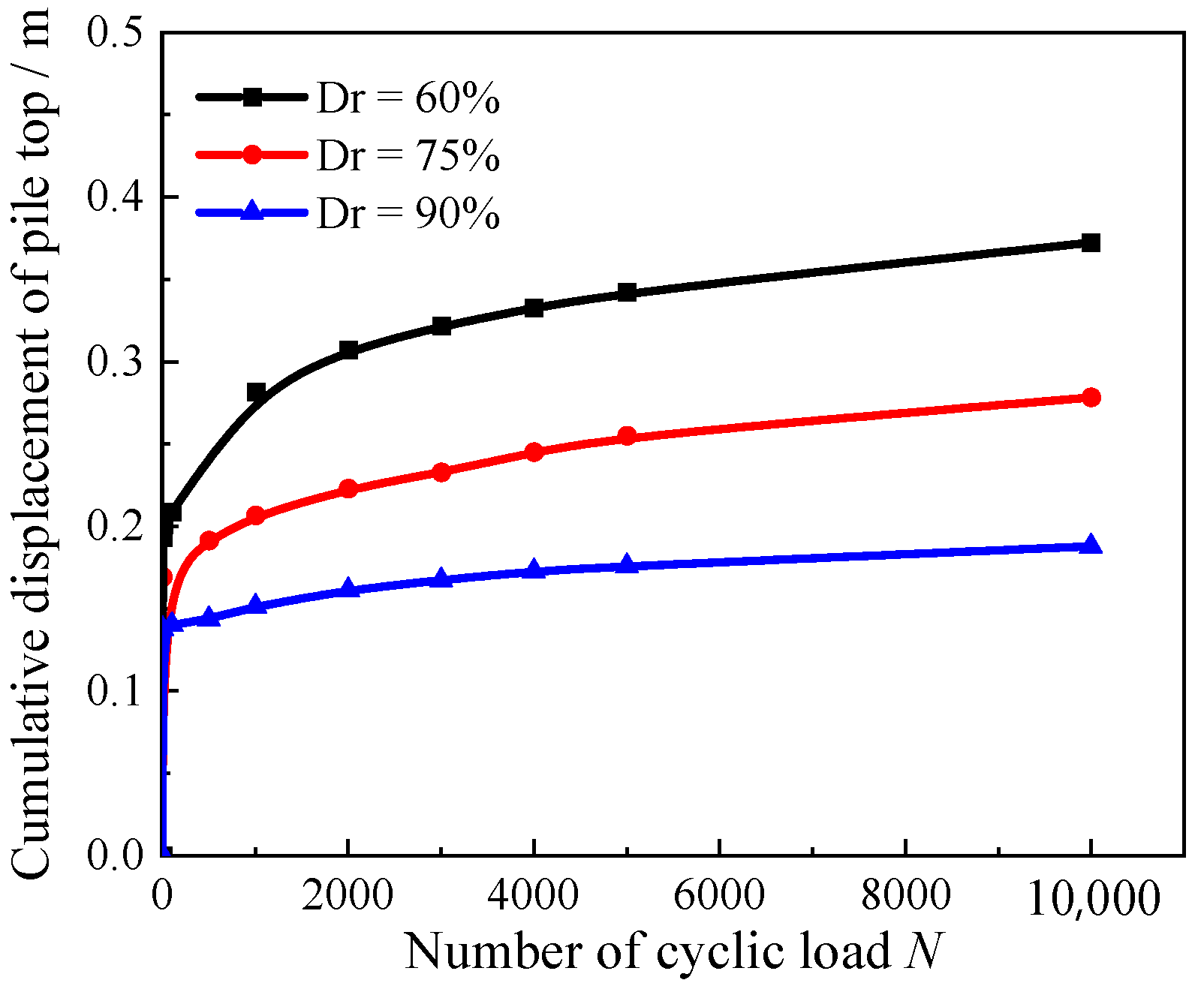



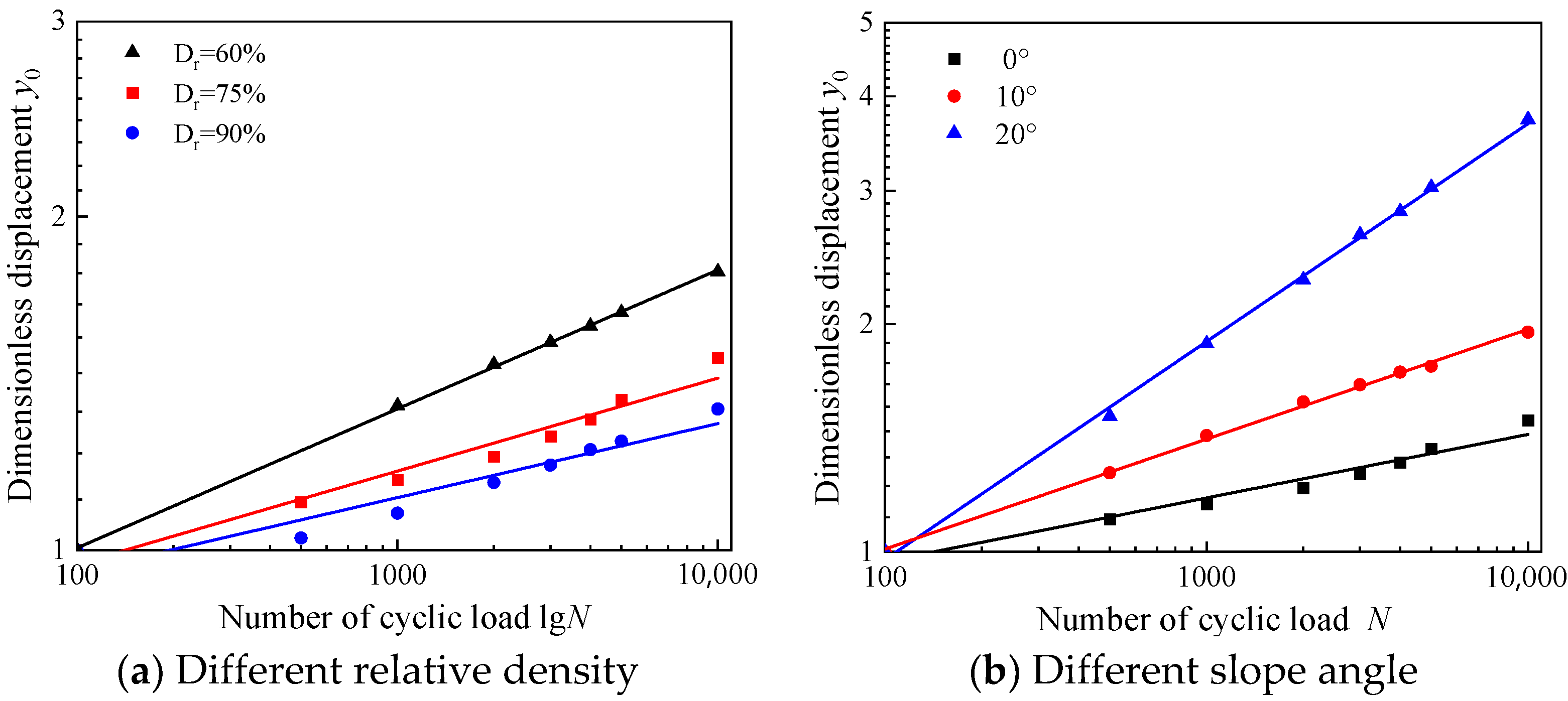
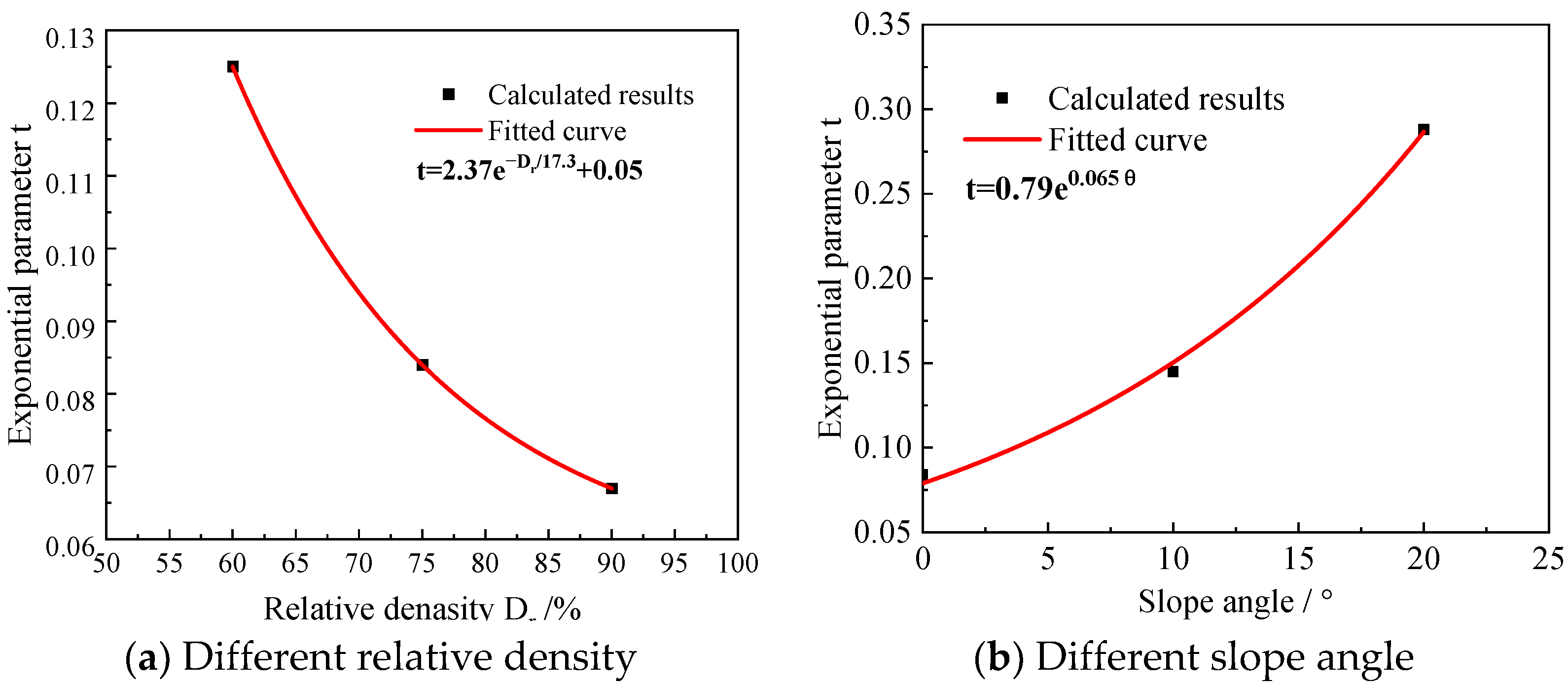
| Parameter | Prototype Pile | Model Pile | Similar Ratio |
|---|---|---|---|
| Diameter/m | 3.0 | 0.03 | 100 |
| Length/m | 50 | 0.5 | 100 |
| Burial depth/m | 30 | 0.32 | 93.75 |
| Bending stiffness/kN·m2 | 1.23 × 1011 | 1788.32 | 7 × 107 |
| Stiffness ratio of pile–soil | 7.76 × 10−3 | 8.53 × 10−3 | 0.91 |
| Mass of supper structure/kg | 3 × 105 | 0.3 | 106 |
| Gs | d50/mm | Cu | Cc | ρmax/(g/cm3) | ρmin/(g/cm3) | emax | emin |
|---|---|---|---|---|---|---|---|
| 2.626 | 0.75 | 2.63 | 1.04 | 1.745 | 1.55 | 0.77 | 0.519 |
| No | Lateral Cyclic Load | Vertical Load/N | Slope Angle/° | Cyclic Number | |
|---|---|---|---|---|---|
| Amplitude/N | Frequency/Hz | ||||
| C1~2 | 16 | 0.1 | 0 3 | 0 | 5000 |
| C3~4 | 16 | 10 | |||
| C5~6 | 16 | 20 | |||
| Influence Coefficient of Modulus/λ | Influence Coefficient of Depth/k | Poisson Ratio | Dilatancy Angle/° | Friction Angle/° |
|---|---|---|---|---|
| 450 | 0.65 | 0.275 | 5 | 36 |
| Relative Density/% | Influence Coefficient of Modulus/λ | Influence Coefficient of Depth/k | Poisson Ratio | Dilatancy Angle/° | Friction Angle/° |
|---|---|---|---|---|---|
| 60 | 400 | 0.6 | 0.250 | 5 | 35 |
| 75 | 500 | 0.55 | 0.225 | 7.5 | 37.5 |
| 90 | 700 | 0.5 | 0.200 | 10 | 40 |
Disclaimer/Publisher’s Note: The statements, opinions and data contained in all publications are solely those of the individual author(s) and contributor(s) and not of MDPI and/or the editor(s). MDPI and/or the editor(s) disclaim responsibility for any injury to people or property resulting from any ideas, methods, instructions or products referred to in the content. |
© 2025 by the authors. Licensee MDPI, Basel, Switzerland. This article is an open access article distributed under the terms and conditions of the Creative Commons Attribution (CC BY) license (https://creativecommons.org/licenses/by/4.0/).
Share and Cite
Lai, Y.; Xiong, G.; He, B.; Sun, Y.; Guo, L.; Liu, K. Numerical Simulation and Tests of Lateral Bearing Capacity of Sloped Offshore Monopile Under Vertical Load and Lateral Cyclic Load. J. Mar. Sci. Eng. 2025, 13, 2153. https://doi.org/10.3390/jmse13112153
Lai Y, Xiong G, He B, Sun Y, Guo L, Liu K. Numerical Simulation and Tests of Lateral Bearing Capacity of Sloped Offshore Monopile Under Vertical Load and Lateral Cyclic Load. Journal of Marine Science and Engineering. 2025; 13(11):2153. https://doi.org/10.3390/jmse13112153
Chicago/Turabian StyleLai, Yongqing, Gen Xiong, Ben He, Yilong Sun, Lin Guo, and Kaiyuan Liu. 2025. "Numerical Simulation and Tests of Lateral Bearing Capacity of Sloped Offshore Monopile Under Vertical Load and Lateral Cyclic Load" Journal of Marine Science and Engineering 13, no. 11: 2153. https://doi.org/10.3390/jmse13112153
APA StyleLai, Y., Xiong, G., He, B., Sun, Y., Guo, L., & Liu, K. (2025). Numerical Simulation and Tests of Lateral Bearing Capacity of Sloped Offshore Monopile Under Vertical Load and Lateral Cyclic Load. Journal of Marine Science and Engineering, 13(11), 2153. https://doi.org/10.3390/jmse13112153






